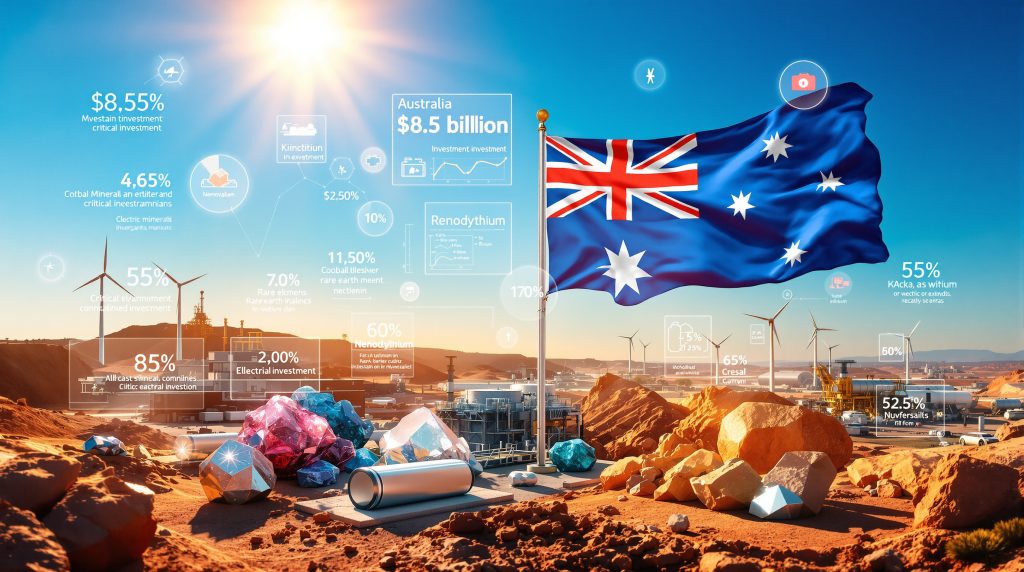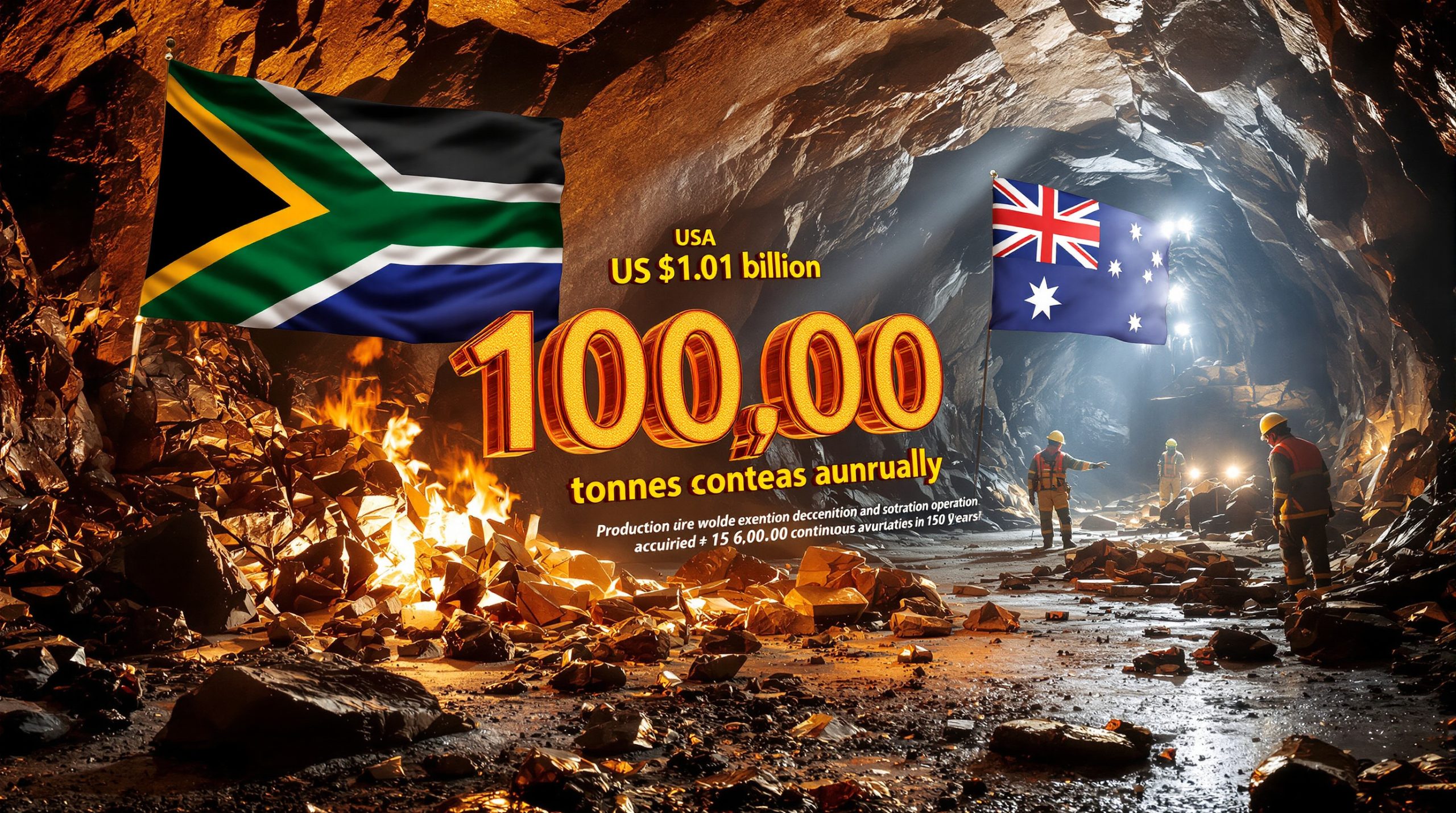Strategic Partnership Framework for Critical Materials
The bilateral agreement between the United States and Australia establishes a comprehensive framework targeting 17 essential materials crucial for modern technological infrastructure. This US-Australia critical minerals deal represents the largest critical minerals partnership in Western history. The partnership encompasses joint financing mechanisms, coordinated development protocols, and enhanced scrutiny of foreign investment activities within Australia's resource sector.
The framework represents more than traditional trade cooperation, creating an integrated approach to supply chain resilience across allied economies. Government-backed financing combines with private sector expertise to accelerate project development timelines while reducing traditional mining investment risks.
Essential Materials Driving Modern Innovation
Critical minerals serve as fundamental building blocks for contemporary technological advancement. Electric vehicle batteries depend heavily on lithium, cobalt, and nickel for energy storage capacity. Wind turbines require neodymium and praseodymium to manufacture permanent magnets that convert kinetic energy into electricity efficiently.
Defense systems rely extensively on specialized materials including:
• Gallium for radar and communication systems
• Rare earth elements for precision-guided munitions
• Titanium for aerospace applications
• Scandium for advanced alloy development
Semiconductor manufacturing utilises gallium arsenide and other compound semiconductors for high-frequency applications in 5G networks, satellite communications, and advanced computing systems. The strategic importance of these materials has grown exponentially as digital transformation accelerates across all economic sectors.
Investment Commitment Structure and Financial Framework
The critical minerals energy transition establishes an investment pipeline exceeding $8.5 billion, representing one of the largest bilateral resource partnerships in modern history. Initial commitments from both governments surpass $3 billion within the first six months, demonstrating unprecedented urgency in supply chain diversification efforts.
Investment Distribution Analysis:
| Funding Category | Amount (USD) | Strategic Focus Area |
|---|---|---|
| US Federal Commitment | $1.2+ billion | Processing infrastructure development |
| Australian Government Investment | $1.1+ billion | Mining capacity expansion |
| Export-Import Bank Financing | $2.2+ billion | Priority project acceleration |
| Private Sector Participation | $4+ billion | Operational scaling initiatives |
Export-Import Bank Priority Development Initiative
The Export-Import Bank of the United States issued Letters of Interest totalling over $2.2 billion across seven strategically significant Australian developments. These projects encompass comprehensive mineral processing capabilities including rare earth separation, graphite purification, magnesium extraction, and titanium refinement operations.
Letters of Interest differ from binding commitments but signal strong governmental support for viable projects meeting technical and financial criteria. This financing approach reduces development risk while maintaining competitive selection processes among potential recipients.
Bilateral Coordination and Oversight Mechanisms
Joint Development and Financing Protocols
The agreement establishes coordinated investment protocols combining sovereign capital deployment with private sector mobilisation. Both nations commit to supporting midstream processing facilities, addressing critical gaps in Western refining capabilities that currently limit supply chain independence.
Furthermore, financing mechanisms include subordinated debt structures where government entities accept higher risk positions to attract private capital participation. This approach leverages public resources to unlock substantially larger private investment flows while maintaining market-driven efficiency incentives.
Supply Chain Security Response Coordination
A bilateral oversight body coordinates priority mineral identification, vulnerability assessments, and accelerated delivery mechanisms under the partnership framework. This group maintains direct communication channels between government agencies and industry participants to address emerging supply chain disruptions rapidly.
The coordination mechanism includes quarterly strategic reviews, annual vulnerability assessments, and emergency response protocols activated during supply chain disruptions. Real-time monitoring systems track global mineral flows and identify potential bottlenecks before they impact allied manufacturing capabilities.
Foreign Investment Review Enhancement
Enhanced provisions strengthen scrutiny of foreign acquisitions targeting strategic mineral assets, particularly those involving entities from non-allied nations seeking control over critical supply chain components. Australia's Foreign Investment Review Board receives expanded authority to evaluate national security implications beyond traditional economic considerations.
The review process examines potential acquirers' connections to foreign governments, technology transfer risks, and alignment with allied strategic interests. Rejected transactions may face mandatory divestment requirements if completed before enhanced scrutiny implementation.
Priority Project Selection and Government Support
Alcoa-Sojitz Gallium Recovery Development
Located in Western Australia, this integrated gallium recovery initiative represents a flagship example of bilateral cooperation in critical materials development. The project leverages existing bauxite processing infrastructure to extract gallium during aluminium refining operations, minimising environmental impact while maximising resource utilisation.
Expected production capacity targets approximately 40 tonnes annually once fully operational, representing roughly 10% of global gallium demand. Government support approaches $200 million in combined Australian equity investment and US financing participation, demonstrating substantial public sector confidence in project viability.
Gallium applications span defence radar systems, satellite communications, and high-efficiency solar panels. The strategic importance of domestic gallium production has intensified following Chinese export restrictions on gallium and germanium compounds in 2023.
Arafura Nolans Rare Earth Integration
The Northern Territory project secures $100 million in Australian equity investment while pursuing additional US financing support. This integrated mining and processing operation targets annual production of 4,400 tonnes of neodymium-praseodymium oxide, representing approximately 5% of projected global demand.
The Nolans Project demonstrates advanced development status with existing offtake agreements securing substantial production volumes:
• Hyundai Motor Company: 1,500 tonnes annually over 10 years
• Siemens Gamesa: 1,500 tonnes annually over 10 years
• Additional partnerships under negotiation
Located 135 kilometres north of Alice Springs, the project encompasses mining, beneficiation, chemical processing, and rare earth separation at a single integrated site. This approach reduces transportation costs and processing risks while maintaining quality control throughout the production chain.
Strategic Selection Criteria Implementation
Priority developments demonstrate advanced permitting status, proven resource bases, and direct alignment with allied supply chain objectives. Projects must exhibit environmental compliance meeting both nations' regulatory requirements while maintaining community engagement standards appropriate for long-term operations.
Selection criteria emphasise technical feasibility, management capability, and strategic value rather than purely financial returns. Government participation requires demonstrated private sector co-investment and credible pathways to commercial viability within reasonable timeframes.
Addressing Chinese Market Dominance Through Diversification
Current Market Control Statistics
China maintains approximately 70% of global rare earth mining capacity while controlling over 85% of refining operations worldwide. This concentration creates strategic vulnerabilities for Western economies dependent on these materials for defence systems, renewable energy technologies, and advanced manufacturing processes.
Global Processing Control Analysis:
| Value Chain Stage | Chinese Market Share | Western Capacity | Development Timeline |
|---|---|---|---|
| Raw Material Mining | ~70% | Australia, USA, Canada | 2-3 years expansion |
| Separation & Refining | ~85% | Lynas, MP Materials | 3-5 years scaling |
| Magnet Manufacturing | ~90% | Limited production | 5-7 years development |
| Advanced Components | ~95% | Emerging capabilities | 7-10 years maturation |
Chinese dominance resulted from decades of technology investment, environmental externalisation, and subsidised electricity costs that enabled competitive pricing despite processing complexity. Western competitors face higher environmental standards and energy costs but benefit from political stability and transparent regulations.
Integrated Supply Chain Development Strategy
The partnership establishes alternative supply pathways through comprehensive "mine-to-magnet" operations within allied territories. This approach reduces dependence on Chinese processing while building domestic value-added manufacturing capabilities across the entire supply chain.
However, the pivot to critical minerals requires substantial capital investment but provides supply chain transparency and quality control unavailable through fragmented global sourcing approaches.
Mine-to-magnet integration encompasses:
- Resource extraction and concentration
- Chemical separation and purification
- Alloy development and magnet manufacturing
- Component assembly and system integration
ASX Mining Companies Positioned for Strategic Benefit
Market Response and Valuation Framework Changes
Following the partnership announcement, shares of major rare earth producers experienced significant trading activity as investors recognised strategic value creation potential from government-backed financing and enhanced offtake visibility.
The agreement introduces multi-layered valuation framework changes for critical mineral stocks. Government financing reduces project development risks traditionally associated with mining ventures. Consequently, strategic offtake agreements provide earnings visibility extending beyond conventional commodity cycles.
Institutional Capital Flow Expectations
Medium-term institutional investment patterns will increasingly favour integrated operations with confirmed offtake contracts, environmental compliance certifications, and domestic processing capabilities. This preference shift may accelerate consolidation among smaller exploration companies lacking scale or advanced development status.
Institutional investors prioritise companies demonstrating:
• Proven management teams with operational experience
• Advanced permitting and community relations
• Diversified customer bases reducing concentration risk
• Environmental and social governance compliance
Leading ASX Beneficiaries and Strategic Positioning
Lynas Rare Earths: Established Market Leadership
Operating the Mount Weld mine and Malaysian separation facilities, Lynas represents the primary non-Chinese rare earth producer globally. The company's integrated operational model aligns directly with partnership objectives, particularly considering existing US Department of Defense funding for Texas processing facilities.
Lynas Operational Highlights:
• FY 2024 Revenue: ~A$836 million
• Primary Output: Neodymium-praseodymium oxides
• Strategic Position: Integrated mine-to-market operations
• Government Partnerships: US defense contract holder
Lynas benefits from established production capabilities, existing customer relationships, and proven technical expertise in rare earth separation. The company's Malaysian facilities provide processing scale difficult for new entrants to replicate quickly.
Arafura Rare Earths: Development Stage Opportunity
The Nolans Project represents significant neodymium-praseodymium production potential through vertically integrated operations near Alice Springs. Government recognition as priority development enhances funding prospects while reducing traditional execution risks associated with mining project development.
Arafura Strategic Metrics:
• Expected Output: 4,400 tonnes NdPr oxide annually
• Secured Offtake: Hyundai and Siemens Gamesa partnerships
• Development Status: Construction phase advancement
• Strategic Value: Integrated processing capability
The project's central Australian location provides access to skilled mining workforce while maintaining proximity to established transportation infrastructure. Integrated processing eliminates dependence on overseas separation facilities.
Iluka Resources: Diversified Processing Strategy
While primarily known for mineral sands production, Iluka's Eneabba rare earth refinery represents Australia's first integrated processing facility designed specifically for domestic rare earth separation. The project leverages existing operational infrastructure while processing monazite by-products from established mineral sands operations.
Iluka Strategic Framework:
• Government Support: A$1.25 billion Critical Minerals Facility loan
• Processing Approach: Monazite concentrate utilisation
• Risk Profile: Diversified revenue through mineral sands
• Operational Advantage: Existing infrastructure leverage
Iluka's approach reduces mining risk by utilising existing by-product streams while developing rare earth processing capabilities. This model provides exposure to strategic mineral markets without complete dependence on rare earth pricing volatility.
Investment Risks and Market Reality Assessment
Development Timeline Considerations
Rare earth project development typically requires 5-7 years from initial permitting through commercial production. The full economic impact of the partnership will unfold gradually as individual projects reach operational milestones rather than delivering immediate investor returns.
Complex environmental permitting processes, community consultation requirements, and technical commissioning challenges contribute to extended development timelines. For instance, uranium mining suspension in other regions demonstrates how operational challenges can affect project timelines.
Commodity Price Volatility Factors
Rare earth pricing remains subject to Chinese export policy changes, fluctuating demand patterns, and technological substitution developments. Neodymium-praseodymium oxide prices demonstrate significant volatility, with estimates ranging around $70,000 per tonne during 2024 depending on grade specifications and delivery terms.
Price volatility stems from:
• Limited supplier diversity globally
• Chinese policy intervention capability
• Technological demand fluctuations
• Inventory management cycles
Environmental and Regulatory Challenges
Rare earth processing generates radioactive waste requiring sophisticated management systems meeting strict regulatory standards. Thorium and uranium naturally occur in rare earth ores, creating disposal challenges that increase operational complexity and costs.
Regulatory approval delays or community opposition could substantially increase project costs while extending development timelines. Environmental impact assessments require comprehensive waste management plans, water usage protocols, and rehabilitation strategies.
Geopolitical Retaliation Possibilities
Beijing retains leverage over refining technology and could implement economic countermeasures responding to Western supply chain diversification efforts. Previous export restrictions on gallium and germanium demonstrate Chinese willingness to utilise resource control for geopolitical objectives.
Furthermore, the US-China trade impact includes technology transfer restrictions, competitive pricing strategies, or expanded domestic consumption reducing export availability. Allied supply chains must prepare for potential disruptions during transition periods.
Global Supply Chain Transformation Implications
Western-Allied Supply Architecture Development
The agreement establishes foundational elements for comprehensive supply chain resilience extending across allied economies. This architecture encompasses broader Indo-Pacific partnerships and European Union coordination beyond bilateral US-Australia cooperation.
Regional supply chain networks reduce single-point-of-failure risks while maintaining competitive cost structures through specialisation and scale economies. Allied coordination prevents destructive competition while encouraging innovation and efficiency improvements.
Technology Transfer and Innovation Acceleration
Joint development initiatives facilitate technology sharing in advanced processing techniques, environmental management systems, and efficiency optimisation protocols. Collaborative research accelerates capability development across both nations while reducing individual development costs.
Innovation partnerships include:
• University research collaboration
• Industry technology sharing agreements
• Government laboratory cooperation
• Private sector joint ventures
Manufacturing Ecosystem Expansion
Beyond raw material production, the partnership supports downstream manufacturing capabilities including permanent magnet production, battery component manufacturing, and advanced materials processing. This comprehensive approach creates domestic employment while reducing economic leakage to overseas processing.
Manufacturing ecosystem development requires coordinated infrastructure investment, workforce training programmes, and research facility expansion supporting long-term industrial competitiveness.
Australia's Economic Future and Strategic Positioning
Transformation Beyond Raw Commodity Export
The partnership positions Australia to capture higher-value processing and manufacturing activities rather than simply exporting unprocessed materials to overseas facilities. This structural shift creates domestic employment opportunities while reducing economic dependence on commodity price cycles.
Value-added processing generates substantially higher economic returns per tonne of raw material while creating skilled employment opportunities in regional areas. Processing facilities anchor broader economic development including supporting services and infrastructure improvements.
Strategic Resource Hub Development
Australia emerges as the Western world's primary critical minerals supplier, attracting global capital and technology partnerships. This positioning enhances national economic security while supporting allied defence capabilities through reliable material supplies.
Strategic hub status provides:
• Enhanced international investment flows
• Technology partnership opportunities
• Diplomatic leverage through resource control
• Economic diversification beyond traditional exports
Infrastructure and Capability Enhancement
Government commitments extend beyond individual project funding to encompass broader infrastructure development, skills training initiatives, and research capabilities supporting long-term industry growth. These investments create competitive advantages sustaining Australia's position regardless of specific project outcomes.
Capability building includes specialised education programmes, research facility expansion, and transportation infrastructure improvements supporting efficient resource movement from mining areas to processing facilities and export terminals.
Investment Strategy Framework for Critical Minerals Exposure
Risk-Return Profile Assessment
Conservative investors may favour established producers like Lynas with existing cash flows and proven operational capabilities. Higher-risk appetite investors might consider development-stage opportunities like Arafura with substantial upside potential contingent on successful project execution.
Portfolio diversification across development stages reduces concentration risk while maintaining exposure to sector growth potential. Balanced approaches combine established producers with selected development opportunities based on individual risk tolerance and investment timeframes.
Execution Timing and Milestone Monitoring
Investment success depends more on operational milestone achievement and cash flow generation than policy announcements or market sentiment fluctuations. Investors should monitor construction progress, offtake agreement developments, and financing completion rather than short-term share price movements.
Key milestones include:
• Environmental permit approvals
• Construction commencement
• First production achievement
• Commercial operation certification
Sector Consolidation Expectations
Smaller exploration companies may consolidate to meet funding thresholds required for government participation programmes. This dynamic creates potential acquisition opportunities while reducing the total number of viable investment targets in the sector.
Consolidation benefits include improved technical expertise, enhanced financial capacity, and reduced regulatory compliance costs through economies of scale. Investors should evaluate management capabilities and strategic positioning when assessing consolidation candidates.
Long-term Energy Transition and Defence Implications
Accelerated Clean Energy Deployment
Secure critical mineral supplies remove bottlenecks constraining renewable energy and electric vehicle adoption rates. Supply chain reliability supports more aggressive decarbonisation timelines across allied economies while reducing transition costs through stable material pricing.
Clean energy deployment acceleration includes:
• Expanded wind turbine manufacturing
• Electric vehicle production scaling
• Grid-scale energy storage development
• Solar panel efficiency improvements
Defence Technology Advancement
Assured access to specialised materials enables continued innovation in defence systems, space technologies, and advanced manufacturing capabilities essential for maintaining technological superiority. In addition to this, the recent executive order on critical minerals demonstrates how material security supports research and development investment in next-generation systems.
Defence applications benefit from domestic supply chains providing quality assurance, delivery reliability, and security clearance compatibility unavailable through foreign suppliers subject to export controls or political interference.
Economic Security Integration
The partnership demonstrates integration between resource security and broader economic cooperation, creating resilient supply networks withstanding geopolitical disruptions. Economic security extends beyond material availability to encompass technological capability and industrial capacity.
Integrated economic security includes domestic manufacturing capability, research and development infrastructure, and skilled workforce development supporting long-term competitive advantages independent of foreign suppliers or technology providers. The Australian government's framework with the United States provides comprehensive details on bilateral cooperation mechanisms.
However, implementation will require sustained political commitment and adequate funding from both nations. The success of this US-Australia critical minerals deal depends on maintaining bipartisan support through electoral cycles and adapting to evolving global security challenges that may affect supply chain priorities.
Disclaimer: This analysis is based on publicly available information as of October 2025. Investment decisions should consider individual circumstances, risk tolerance, and professional financial advice. Critical minerals markets involve substantial risks including price volatility, regulatory changes, and project execution challenges. Past performance does not guarantee future results, and government policy support may change based on political developments or budget constraints.
Ready to Identify the Next Critical Minerals Opportunity?
Discovery Alert's proprietary Discovery IQ model delivers real-time alerts on significant ASX mineral discoveries, instantly empowering subscribers to identify actionable opportunities ahead of the broader market. Understand why historic discoveries can generate substantial returns by visiting Discovery Alert's dedicated discoveries page, showcasing exceptional outcomes from companies positioned to benefit from strategic partnerships like this US-Australia critical minerals deal.




